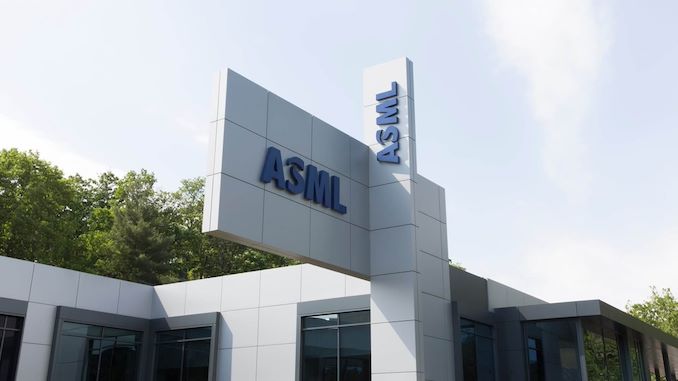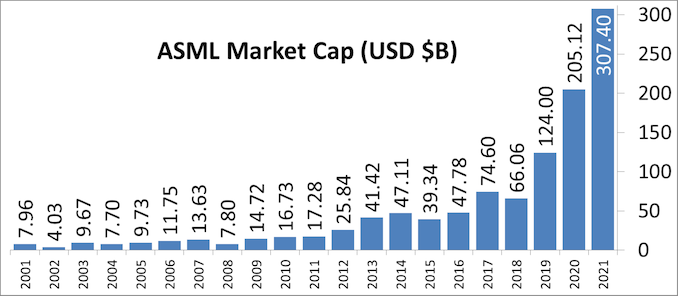Intel's Process Roadmap to 2025: with 4nm, 3nm, 20A and 18A?!
by Dr. Ian Cutress on July 26, 2021 5:00 PM ESTSidebar on Intel EUV
In all of these announcements, one thing to highlight is Intel mentioning its relationship with ASML, the sole company that manufactures the EUV machines powering production of leading edge semiconductor manufacturing.
ASML is a unique company in that it is the only one that can produce these machines, because the technology behind them is often tied up with its partners and research, but also because all the major silicon manufacturers are heavily invested in ASML. For any other company to compete against ASML would require building a separate network of expertise, a decade of innovation and design, and a lot of capital. None of the major silicon vendors want to disturb this balance and go off on their own, lest it shuts them out of the latest manufacturing technology, and no research fund sees competing against the embedded norm as a viable opportunity. This means that anyone wanting EUV specialist technology has to go to ASML.
In 2012, it was reported that Intel, Samsung, and TSMC all invested in ASML. This was, at the time, to jumpstart EUV development along with migrating from 300mm wafers to 450mm wafers. While we haven’t moved to 450mm wafers yet (and there are doubts we will any time in the next decade), EUV is now here. Intel’s 2012 investment of $2.1 billion gave them a 10% stake in ASML, with Intel stating that it would continue investing up to a 25% stack. Those stakes are now below the 5% reporting threshold, but all three of the major foundry customers are still big owners, especially as ASML’s market cap has risen from $24 Billion in 2012 to $268 Billion in 2021 (surpassing Intel).
As major investors but also ASML’s customers, the race has been on for these foundries to acquire enough EUV machines to meet demand. TSMC reported in August 2020 that it has 50% of all EUV machines manufactured at ASML for its leading edge processes. Intel is a little behind, especially as none of Intel’s products in the market yet use any EUV. EUV will only intercept Intel’s portfolio with its new Intel 4 process, where it will be used extensively, mostly on the BEOL. But Intel still has to order machines when they need them, especially as there are reports that ASML currently has backorders of 50 EUV machines. In 2021, ASML is expected to manufacture around 45-50 machines, and 50-60 in 2022. The exact number of machines Intel has right now, or has ordered from ASML, is unknown. It is expected that each one has a ~$150m price tag, and can take 4-6 months to install.
With all that being said, Intel’s discussion point today is that it will be the lead customer for ASML’s next generation EUV technology known as High-NA EUV. NA in this context relates to the ‘numerical aperture’ of the EUV machine, or to put simply, how wide you can make the EUV beam inside the machine before it hits the wafer. The wider the beam before you hit the wafer, the more intense it can be when it hits the wafer, which increases how accurately the lines are printed. Normally in lithography to get better printed lines, we move from single patterning to double patterning (or quad patterning) to get that effect, which decreases yield. The move to High-NA would mean that the ecosystem can stay on single patterning for longer, which some have quoted as allowing the industry to ‘stay aligned with Moore’s Law longer’.
| ASML's EUV Shipments | |||||||||||||||||||||
| 2015 | 2016 | 2017 | 2018 | 2019 | 2020 | 2021 | |||||||||||||||
| Actual | 2 | 4 | 10 | 3 | 4 | 5 | 6 | 4 | 7 | 7 | 8 | 4 | 7 | 14 | 8 | 7 | 9 | - | - | ||
| Target (Total) | - | - | - | 20 (18) | 30 (26) | 35 (33) | 45-50 | ||||||||||||||
| 2018 and beyond is split per quarter for actual shipped numbers Data taken from ASML's Financial Reports |
|||||||||||||||||||||
Current EUV systems are NA 0.33, while the new systems are NA 0.55. ASML’s latest update suggests that it expects customers to be using High-NA for production in 2025/2026, which means that Intel is likely going to be getting the first machine (ASML NXE:5000 we think) in mid-2024. Exactly how many High-NA machines ASML intends to produce in that time frame is unknown, as if they flood the market, having the first won’t be a big win. However if there is a slow High-NA ramp, it will be up to Intel to capitalize on its advantage.













326 Comments
View All Comments
s.yu - Tuesday, July 27, 2021 - link
So...NA 0.33 is f/3, NA 0.55 is f/1.82?dsplover - Tuesday, July 27, 2021 - link
Hope it happens, more choices for us since Intel has only had some i5’s worth buying in the last 2 years.Single Core scores got me interested again. But marketing hype on TDP and nm size is still a tad too high compared to AMD.
I like the negative -nm response. Humor and competition make me happy.
eldakka - Tuesday, July 27, 2021 - link
" Intel believes it can follow an aggressive strategy to match and pass its foundry rivals"Isn't that exactly what caused their failures with 10nm? The blame for the repeated delays was usually put on them being too agressive with their 10nm shrink, attempting too big reductions in feature sizes, increases in density, etc.
whatthe123 - Wednesday, July 28, 2021 - link
That's true but it was also because they were still ahead of everyone else with 14nm so they continued shooting for unrealistic goals on 10nm instead of just accepting the density loss and shipping something, which is basically what they've done with their SF/ESF updates. They also weren't willing to eat margins to ship products and enjoyed huge profits for a long time.If they accept the costs and react fast to failing strategies then maybe they can actually ship something closer to TSMC's timeline instead of being years behind. Either way they have to be aggressive considering TSMC is still improving.
Oxford Guy - Wednesday, July 28, 2021 - link
The word aggressive signals desperation in this context.mode_13h - Thursday, July 29, 2021 - link
Aggressively pursuing density can also serve greed, since it means more dies per wafer -> bigger profit margins. I think this is the more plausible explanation, because Intel had a comfortable lead at the time they were initially designing their 10 nm process.Heh, I feel sorta weird for having to point that out to you.
Oxford Guy - Tuesday, August 3, 2021 - link
Apples and oranges.Peskarik - Wednesday, July 28, 2021 - link
By 2025 most will not give a s about some processorsPeskarik - Wednesday, July 28, 2021 - link
naming should be more positive, more inventive and more inclusiveunicorn
duecorn
tripplecorn
fourcorn
and, as apotheosis, hornycorn
GeoffreyA - Friday, July 30, 2021 - link
I doubt whether the Censorship Department at Intel HQ will let the last one through.